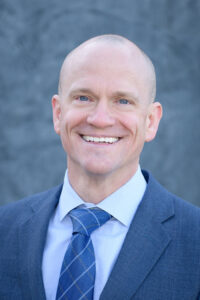Organization works to protect, improve region's waterways

Neil Maunu began as executive director of the Pacific Northwest Waterways Association (PNWA) in August 2023. The Washington Grain Commission (WGC) is a member of PNWA, which is a nonprofit, nonpartisan trade association of ports, businesses, public agencies, and individuals who support navigation, energy, trade, and economic development throughout the region.
WGC CEO Casey Chumrau recently sat down with Maunu to talk about how their two organizations can best work together to maintain our region’s transportation systems and advance the goals of Washington’s farmers. Their conversation is edited for length and clarity.

CASEY: The members of PNWA are quite diverse. Could you tell us a little about the membership and what the advantages are by including a variety of industries and partners?
NEIL: We have over 150 members in Oregon, Washington, and Idaho. Our members include public ports, farmers, irrigators, grain elevators, marine terminals, cruise lines, electrical utilities, trade associations, organized labor, steamship operators, river and bar pilots, barge companies, and more.
One of the key benefits of having a diverse membership base is the networks and relationships it creates. It’s terrific to see ports and businesses making connections, as well as
consultants helping ports with long-standing challenges. We have the right mix of partners involved to facilitate thoughtful discussions, not to mention our most crucial, value-add,
which is our relationship with the U.S. Army Corps of Engineers and the Pacific Northwest congressional delegation.
CASEY: You are new to your position but have a long history with the Columbia-Snake River System. How do you think the next five years are going to be different than the last five in terms of river issues?
NEIL: I started working in the maritime industry here in the region when I left the Army as an active-duty aviation officer in 2007. We saw some changes to container exports from the river in the mid-2010s that are still evolving.
In 2015, the Port of Portland ceased container operations, started back up in 2020, and recently announced they will continue operating the container terminal but don’t currently plan to accommodate barged containers. Pulses, grains, hay, and refrigerated cargo previously moved on the river at a rate of nearly 15,000 containers annually. Now, that volume is zero. Shippers went to rail and truck, and once those modes were in place, it has been tough to get cargo to return to the waterways.
We’re also seeing a shift to more renewable products on the river system. Renewable diesel and biodiesel with blending capability have sprung up at several terminals on the Columbia and Snake rivers, and there are plans for several renewable energy projects on the horizon, not to mention the ability to move wind energy components on the river and get them off the highways. I anticipate more of these trends to continue.
CASEY: The litigation on the Snake River dams is on hold for a least five years. What does that mean for PNWA and river users in general?
NEIL: It means we are fully focused on continuing education, outreach, and advocacy for river navigation and our support for the lower Snake River dams. The Inland Ports and avigation Group (IPNG), a subset of PNWA consisting of inland river users who have partnered to protect the lower Snake River dams through litigation and advocacy, have been involved in this
process for nearly 22 years. Instead of just our advocacy in Congress or in the courtroom, we will have to reach out to the public and focus on what we call the third “C” — communication and outreach — a three-legged stool propped up by advocacy, active involvement in litigation, and communicating the benefits of the river system.
After five years, the litigation parties will re-evaluate progress on commitments that are called out in the stay agreement. If either party is not satisfied with the progress of these commitments, the stay may be terminated, and the parties could go back to litigation. The legal forbearance on the stay is very narrow and only applies to Endangered Species Act rulings. We may see further litigation pertaining to issues like Clean Water Act violations brought forth by environmental justice groups and other organizations.
CASEY: What is your vision for PNWA in the next one to five years?
NEIL: It’s all about relationships. Since 1934, when we began advocating for a navigation lock on the yet-to-be-built Bonneville Dam, we have been educating Congress and working with our federal partners to ensure our members’ needs are met. Those relationships will be critical as we move forward over the next five years.
CASEY: What do you see as the biggest challenges to realizing your goals?
NEIL: The PNWA staff team (five of us) is a relatively new group. The challenge will be for this new staff to continue building relationships and adding value to our growing membership base.
We are seeing a drastic shift from our previous focus of courtroom litigation and congressional advocacy to a broader approach that includes tracking state and federal studies, ensuring appropriations are in line with our values, implementing a strong communications plan to further educate the public, and conducting targeted public and media outreach. We have amazing support from our members, who are involved in our working groups and committees and active on our executive committee both for PNWA and IPNG — we couldn’t do it without the amazing support from our officers, board, and members.
CASEY: How do you hope to engage with grain growers?
NEIL: Like I said, it’s all about relationships! PNWA is already fully engaged with several regional grower groups and farmers with whom we have a great relationship. Michelle Hennings, with the Washington Association of Wheat Growers (WAWG), and the WGC are actively involved, as are Oregon and Idaho. It’s our goal moving forward to leverage our ag partners to help educate others outside of our region and to tell the story of the importance of this river system. Additionally, many of PNWA’s members are growers and co-ops, and we engage with them often, including them in working groups and committees.
CASEY: What are the biggest challenges to getting more people aware of how the river system impacts agriculture, the economy, or even their own lives?
NEIL: This is a great question. Our mantra for this year is to be “provocative.” We want people to understand how impactful the river system is to our economy and to our nation. The work we must do in our region is to first educate folks on what moves, and how things move, on our river system, and then dial in on the importance of those facts.
CASEY: How can the grain industry be more proactive and help ensure the sustainability of the transportation system?
NEIL: The ag community is passionate about the river system’s value, not just to the farmer but to the community and all stakeholders. Being involved is the number one thing we can all do. As state and federal studies are conducted, stakeholders must reach out to those relevant agencies and be heard. PNWA will continue to work with the grain industry and ag community to find ways to partner publicly, in Congress and across the nation. The more we speak with one voice in support of the sustainability of the Columbia-Snake River System, the more power we have.
CASEY: Any final thoughts?
NEIL: I think the grain industry is fantastic. WGC and WAWG have been amazing partners to PNWA and IPNG for many years, and to me, personally, since I’ve been in this role over the last year. Thank you, Casey, so much for your unwavering support, for standing (or sitting!) next to me in Washington, D.C., when we testified in Congress in support of the economic benefits of river commerce in our region, and for your dedication to the benefits of a robust river transportation system and multimodal network.
This article originally appeared in the June 2024 issue of Wheat Life Magazine.
